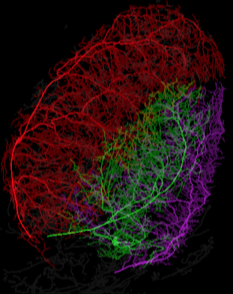-
Core
Including general data stuctures for 3D volume, data I/O, data visualization, simple 3D image processing and etc.
-
Vesselness
This is a C++ implementation of Vesselness Measure for 3D volume based on the following paper Frangi.
- Frangi, Alejandro F., et al. "Multiscale vessel enhancement filtering." Medical Image Computing and Computer-Assisted Interventation—MICCAI’98. Springer Berlin Heidelberg, 1998. 130-137.
Two sample code is provided in
main.cpp:- Computing vesselness measure
- Extracting the vessel centrelines with non-maximum suppression
Sample Usage:
-
Setting parameters:
[
sigma_from,sigma_to]: the potential size rang of the vesselssigma_step: precision of computationFor other parameters
alpha,beta,gamma, please refer to Frangi's papaer or this blog or Frangi's paper.float sigma_from = 1.0f; float sigma_to = 8.10f; float sigma_step = 0.5f; float alpha = 1.0e-1f; float beta = 5.0e0f; float gamma = 3.5e5f; -
Laoding data
Data3D<short> im_short; bool flag = im_short.load( "dataname.data" ); if(!flag) return 0; -
Compute Vesselness
Data3D<Vesselness_Sig> vn_sig; VesselDetector::compute_vesselness( im_short, vn_sig, sigma_from, sigma_to, sigma_step, alpha, beta, gamma ); -
Saving Data
vn_sig.save( "dataname.vn_sig" ); -
If you want to visulize the data using maximum-intensity projection
viewer.addObject( vn_sig, GLViewer::Volumn::MIP ); viewer.addDiretionObject( vn_sig ); viewer.go(600, 400, 2);
-
ModelFitting (Levenberg Marquardt algorithm)
Fitting geometric models (lines) to the 3D vessel data using Levenberg-Marquardt algorithm.
Using Levenberg Marquardt algorithm for energy minimization.
Energy contains two parts:
- Data cost Distance to the center of a line model
- Pair-wise smooth cost Complicated. Please refer to this paper for more details
Levenberg Marquardt algorithm requires to compute the Jacobin matrix for both the data cost and the smooth cost. This computation is very time-consuming and the computation has been highly paralleled in this version.
-
SparseMatrix
Sparse matrix representation, contains all necessary matrix manipulations such as:
- addtion
- subtraction
- multiplication
- transpose
-
SparseMatrixCV
OpenCV warper for SparseMatrix. For matrix multiplication between sparse matrix and dense matrix. For example,
template <class _Tp, int m, int n> SparseMatrixCV operator*( const cv::Matx<_Tp,m,n>& vec, const SparseMatrixCV& sm );Mat_<double> operator*( const SparseMatrixCV& sm, const Mat_<double>& sm ); -
Vesselness-cuda
CUDA version of the vesselness measure (under development)
-
RingsReduction
Rings reduction of CT images (under development)
-
EigenDecomp
Eigenvalue decomposition of a 3 by 3 symmetric matrix
-
Linux
-
X Window System (X11, X, and sometimes informally X-Windows), which is a windowing system for bitmap displays
sudo apt-get install libxmu-dev sudo apt-get install libxi-dev -
OpenGL
sudo apt-get install mesa-common-dev -
glew
sudo apt-get install libglew-dev -
freeglut
sudo apt-get install freeglut3-dev -
OpenCV 2.4.9
Download OpenCV. Generate makefile with cmake, build and install the liabrary.
cmake ./ make make installOne more thing. Make sure you have added the OpenCV lib direcory to PATH by the following.
export LD_LIBRARY_PATH=/usr/local/lib//usr/local/libis where the OpenCV libs are located. You could double check bypkg-config --libs opencv -
Code::Blocks
-
-
Windows
All the code was written in C++. So it shouldn't be hard to modify and adapt to Windows. As a matter of fact, earlier version of the development was under Windows.
Some of the results were eventually published in this paper Thin Structure Estimation with Curvature Regularization. Please check it out :)
